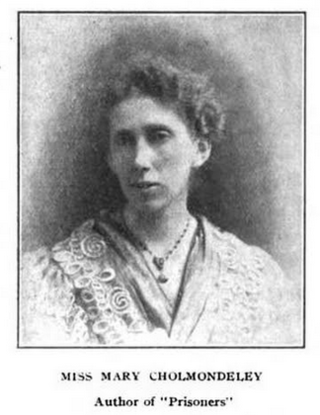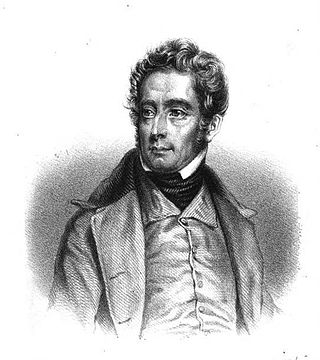This article contains information about the literary events and publications of 1847.

Marie-Joseph "Eugène" Sue was a French novelist. He was one of several authors who popularized the genre of the serial novel in France with his very popular and widely imitated The Mysteries of Paris, which was published in a newspaper from 1842 to 1843.

Mary Cholmondeley was an English novelist. Her bestseller, Red Pottage, satirised religious hypocrisy and the narrowness of country life. It was adapted as a silent film in 1918.

Penny dreadfuls were cheap popular serial literature produced during the 19th century in the United Kingdom. The pejorative term is roughly interchangeable with penny horrible, penny awful, and penny blood. The term typically referred to a story published in weekly parts of 8 to 16 pages, each costing one penny. The subject matter of these stories was typically sensational, focusing on the exploits of detectives, criminals, or supernatural entities. First published in the 1830s, penny dreadfuls featured characters such as Sweeney Todd, Dick Turpin, Varney the Vampire, and Spring-heeled Jack.
James Malcolm Rymer (1814–1884) was a British nineteenth-century writer of penny dreadfuls, and is the probable co-author with Thomas Peckett Prest of both Varney the Vampire (1847) and The String of Pearls (1847), in which the notorious villain Sweeney Todd makes his literary debut.

The Mysteries of Paris is a novel by the French writer Eugène Sue. It was published serially in 90 parts in Journal des débats from 19 June 1842 until 15 October 1843, making it one of the first serial novels published in France. It was an instant success and singlehandedly increased the circulation of Journal des débats. It founded the "city mysteries" genre, spawning many imitations.
John Fenwick Anderson Blackburn was a British novelist who wrote thrillers, and horror novels. Blackburn was described as "today's Master of Horror" by The Times Literary Supplement.

The three-volume novel was a standard form of publishing for British fiction during the nineteenth century. It was a significant stage in the development of the modern novel as a form of popular literature in Western culture.

Michael McEachern McDowell was an American novelist and screenwriter described by author Stephen King as "the finest writer of paperback originals in America today". His best-known work is the screenplay for the Tim Burton film Beetlejuice.

George William MacArthur Reynolds was a British fiction writer and journalist.
Richard Marsh was the pseudonym of the English author born Richard Bernard Heldmann. A best-selling and prolific author of the late 19th century and the Edwardian period, Marsh is best known now for his supernatural thriller novel The Beetle, which was published the same year as Bram Stoker's Dracula (1897), and was initially even more popular, outselling Dracula six times over. The Beetle remained in print until 1960. Marsh produced nearly 80 volumes of fiction and numerous short stories, in genres including horror, crime, romance and humour. Many of these have been republished recently, beginning with The Beetle in 2004. Marsh's grandson Robert Aickman was a notable writer of short "strange stories".

The Lost Continent: The Story of Atlantis (1899) is a fantasy novel by English author C. J. Cutcliffe Hyne. It is considered one of the classic fictional retellings of the story of the drowning of Atlantis, combining elements of the myth told by Plato with the earlier Greek myth concerning the survival of a universal flood and restoration of the human race by Deucalion.

In literature, a serial is a printing or publishing format by which a single larger work, often a work of narrative fiction, is published in smaller, sequential instalments. The instalments are also known as numbers, parts, fascicules or fascicles, and may be released either as separate publications or within sequential issues of a periodical publication, such as a magazine or newspaper.

The London Journal; and Weekly Record of Literature, Science and Art was a British penny fiction weekly, one of the best-selling magazines of the nineteenth century.
Stephen Thomas Knight MA (Oxon.), PhD (Sydney), F.A.H.A., F.E.A. was, until September 2011, a distinguished research professor in English literature at Cardiff University; and is a professorial fellow of Literature at the University of Melbourne. His areas of expertise include medieval English and European literature, Robin Hood, Merlin, cultural studies, crime fiction, and Australian matters. He has authored over thirty books, and is well known in the public sphere for his contribution to a range of fields. His most recent books have been The Politics of Myth (2015), Towards Sherlock Holmes: A Thematic History of Crime Fiction in the 19th Century World (2017), Australian Crime Fiction: A 200-year History (2018), The Fiction of G.W.M. Reynolds: The Man Who Outsold Dickens (2019) and The University is Closed for Open Day: Themes and Scenes from 21st Century Australia (2019).
Elizabeth Caroline Grey (1798–1869), aka Mrs. Colonel Grey or Mrs. Grey, was a prolific English author of over 30 romance novels, silver fork novels, Gothic novels, sensation fiction and Penny Dreadfuls, active between the 1820s and 1867. There is some controversy about the details of her life story, and if she actually authored any penny dreadfuls.
Ruth the Betrayer; or, The Female Spy, by Edward Ellis was the first fictional female detective story. It was published as a penny dreadful in 52 parts in 1862-63 by John Dicks, and the British Library's single-volume compilation copy was acquired on 28 February 1863. It therefore predates Andrew Forrester's The Female Detective and W.S. Hayward's The Revelations of a Lady Detective, both of 1863/4.
City mysteries are a 19th-century genre of popular novel, in which characters explore the secret underworlds of cities and reveal corruption and exploitation, depicting violence and deviant sexuality. They were popular in both Europe and the United States. All were inspired by the very successful serial novel The Mysteries of Paris (1842) by Eugène Sue, such as these:

Percy Bolingbroke St John was an English journalist.
Valancourt Books is an independent American publishing house founded by James Jenkins and Ryan Cagle in 2005. The company specializes in "the rediscovery of rare, neglected, and out-of-print fiction," in particular gay titles and Gothic and horror novels from the 18th century to the 1980s.











